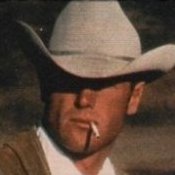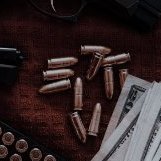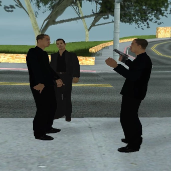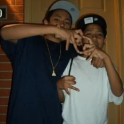Search the Community
Showing results for tags 'paisa'.
-
Camila Delossantos [De Los Santos, a Spanish surname meaning ''of the saints''.] A woman originating from Monterrey, Mexico. This thread follows Camilla's life, a fourth-generation narco-trafficker as she must face the challenges of ethnic stereotyping by the local community and injustice by law enforcement.
-
"ALTO AL FUEGO" - JUANA ALICIA - 1988 La Comunidad aims to portray the Hispanic community of (but not limited to) North San Andreas. The last two decades, the clandestine migration of Mexicans and Central Americans through the Tamaulipas-Texas route has had ups and downs thanks to the economy, and surveillance put into this route. This however has not stopped the so-called "Coyotes" from limiting their presence in the area. What could be the link between the organized crime and the clandestine migration? You may ask, in my experience, the link takes visibility through the "Coyotes" as they are most of the time linked to someone else, they are, what they call in Mèxico, "apadrinados". They are untouchable and they are paying thousands of dollars to someone directly associated to a criminal group known as "La Maña". Beyond the ethnographic and contemporary narratives referring to "La Maña", we present you with the real name of the criminal group in charge of this whole clandestine movement. With approximately 350 kilometers of longitude, the route between Tamaulipas and Texas represents almost a 10% of the whole US-Mexico border. It is a region with a lengthy story of drug trafficking, homicide, human trafficking and so on and someone always controls it. A Northern city of Mèxico is heavily influenced economic wise by this whole route. Sinaloa. The fresh immigrant will do anything for some cash, they do not only have to support themselves, but their entire families. Some of them have families of at least ten members, it's not an easy task but they manage to pull through.
- 82 replies
-
- 43
-

-

-

-
Jorge Torres and he lived at the center of Tlaxcala, right underneath the rays of the sun kissing him on the surface of the sun-bathed hills. Stories of his ancestors’ toughness etched on aged faces withered by time could be heard among murmurs of the village but Jorge’s journey was significantly more difficult than that. It seemed like these winds whispered a message about fate, which translated into suffering and endurance and that characterized his destiny since he was born. Jorge’s family represented a mixture of poverty and resistance. Worn out the farm where Maria and Carlos worked for a living that seems like it bared the brunt of history. The stains on their hands – hardened by generations spent working in that very same soil told a story of thousands of years tied together. However, love grew fiercely within their humble adobe house in spite of poverty. His father spoke of distant lands where there were no limitations, and in turn, he described it as a field without end. On the other hand, his mother spoke of stars that danced above their heads, yet they could not see any moon. However, Tlaxcala was not just a myth. Cartel war strands entailed all across town like thick ropes of danger that were hard to avoid. As Jorge became a man, his innocence eroded into what was brutally true. Long ago people whispered on the streets, and unknown words were heard in the shadows. This was as each year, the menace came closer and the cartel’s power encroached on them. However, they remained steadfast, even with the turbulence. They sought shelter in their ancestors’ past, a dialect referred to as Nauthall which was spoken only within their homes. As they worked together, farm hands bartered some part of this second language with Jorge. It was a whispered gold that strengthened their bond as they faced challenges together. At the age of twenty-one, the weight of destiny was put on the shoulders of Jorge because deep within he felt that his life transcended the confines of his country. A rumor borne by the wind reached his ears, spreading stories of opportunity beyond the border, in the land of dreams and steel: United States of America, Los Santos. The promises made by a coyote were riddled with danger but its spark was stronger than any fears. Travel down the tunnel passage was an unveiling of what they knew nothing about in their entire lives, a cord woven with fear and wonderment. On the other side of Los Santos was Jorge who walked along a spacious area consisting of colorful skyscrapers. However, Jorge's journey was filled with thorns since dreams come at a price. He was fate-tied to a group of crooks who were like-minded in their misfortune like him. They helped him navigate the twisted channels of profit, peril, and life. He found out that his agony was born of the same land and also the fervent fondness in that society for kindred spirit and culture. It was sweat and sacrifices, which made Jorge climb up the rungs of this new world's ladder. Stories can be read between the grits in his fists which denoted his hours sweating out a way of life through hard labor adversities. In every step forward, he shed a slice of his soul to help hold onto life at home for his people in the wake of their loss.
- 24 replies
-
- 26
-

-

-
- paisa
- drug trafficker
-
(and 3 more)
Tagged with:
-
tales of a paisa called andrés cortiguerra
- 23 replies
-
- 5
-

-
- la empresa
- la maña del i-5
-
(and 1 more)
Tagged with:
-
-
- 2
-

-

-
- immigrant
- drug trafficker
-
(and 1 more)
Tagged with:
-
This thread will submit the tales and development of the characters Máximo 'Barba' Sandoval and Ramón 'Bigotón' Molina.
- 2 replies
-
- 7
-

-
- border brothers
- cjng
-
(and 8 more)
Tagged with:
-
Madre mía no tenga cuidado, tus oraciones son mis soldados El sobrino así me apodaron Aprendí ser disimulado This thread will follow the life of Jonatan Landivar
- 12 replies
-
- 11
-

-
The story of Barrios Los Pumas 16 began in the early 2000s in Los Santos, when a group of Mexican immigrants came together to form a gang to protect each other from other hardcore gangs in the area. They called themselves "Los Pumas", after the street on where most of them lived, Cougar Avenue. The gang members were mostly young men who had come to the United States looking for a better life, but found themselves struggling to make ends meet. At first, Los Pumas were just a group of friends who hung out together, drank, and smoked weed. But as they started to get involved in petty crime, their group became more organized. They began to work together to commit robberies, burglaries, and drug deals. They also started to recruit new members, both from within their own community and from other Latino neighborhoods in Los Santos. As their reputation grew, they caught the attention of the larger Mexican-American gang network in the city. At the time a transnational criminal network known as the Paisa Alliance, a collection of Mexican traffickers under the Border Brothers 22 that had formed an alliance for protection and mutual support. The Paisa Alliance was impressed with Los Pumas' organization and discipline, and they offered to bring them into the alliance. At first, some members of the gang were hesitant to join the Paisa Alliance. They were proud of their independence and didn't want to be beholden to anyone else. But as they saw the benefits of joining the alliance - protection from rival gangs, access to more lucrative criminal opportunities, and a sense of belonging to a larger community - they began to pledge their loyalty to the Paisa Alliance. Since joining the Paisa Alliance, Barrio Los Pumas 16 has become one of the most respected and feared gangs in Los Santos. They have expanded their operations to include human trafficking, extortion, and contract killing. But they have also maintained their loyalty to their community, and have used some of their criminal proceeds to support local charities and social programs. The members of the gang know that their life of crime may end in prison or death, but for now, they remain committed to their gang and to the Paisa Alliance.
- 46 replies
-
- 26
-

-
This thread will follow Jorge "Happy" Moruga, a 25 year old proud Mexican, but also a hardened criminal.
- 56 replies
-
- 41
-

-

-
GUIDE TO MTOC ROLEPLAY Myself, Nuke & EGN Introduction Understanding Narco culture USA Paisa Prison culture & Paisa Gangs USA based Paisa plenipotentiaries Females in the Narco underworld Summary Everything above is what you can expect to read about and learn in this guide, the guide itself will be kept somewhat short but still detailed enough to give people a deep insight to how they should roleplay their characters. This guide will be simply what it’s intended for, a guide, so don’t expect me to hold your hand and give you a step by step walkthrough. INTRODUCTION Hey there, if you’re reading this then it’s probably because you want to know more about roleplaying a Mexican National, if so there’s a lot of stuff you need to know about roleplay as a person involved in the Paisa criminal underworld. It can get very tricky and complex, to a point that a lot of stuff can actually get confusing. We’ve personally been roleplaying in the Paisa scene for years and a lot of our knowledge has been gathered through external sources, reading between the lines, speaking to certain individuals that have grown up around Narco traffickers etc, although we’re not experts on the subject, we do believe our knowledge is enough to justify reasoning to make this. Also, lil tip it’s pronounced “Pie-sa”, “Pie-sa-no”, “Pie-sa-na”. UNDERSTAND NARCO CULTURE Understanding Narco culture can be quite confusing at times, especially if you don’t know an awful lot about the background of Mexico, and how traffickers evolved from individual plaza (turf) bosses running their own designated sections, to eventually being aligned to many of the different cartels throughout the country. The thing with Narco traffickers is, at the very beginning they were all mostly from the state of Sinaloa, and keep this in your head because it plays a major connection a bit further into this guide, but originally it was plaza bosses running their own little turfs until Miguel Ángel Félix Gallardo had a bright idea to form Mexico’s first Narco commission, which became known as the Guadalajara Cartel; Mexico’s very first legitimate “Cartel”. But the major thing about this? The Guadalajara Cartel didn’t just become powerful due to having plaza bosses operating as a union under them, quite the opposite, sure it was a part in their power uprise but if it wasn’t for the Dirección Federal de Seguridad (DFS) the Guadalajara Cartel wouldn’t have been anything. The DFS is sort of like the CIA of Mexico, but the FBI at the same time. You’re probably wondering why I’m giving you this rundown, well it’s pretty simple because the Cartels in Mexico are usually backed by someone; the most powerful ones that is. It’s not hard to figure this out of course, but another major part of understanding Narco culture, especially in the modern day and age is to understand the political parties that are in Mexico. See, the thing is parties like MORENA and the Partido Revolucionario Institucional (PRI) are all allegedly backing Cartels to this very day in Mexico. Two examples of this is MORENA allegedly backing the Sinaloa Cartel and the PRI allegedly backing the Jalisco New Generation Cartel. This is one of the biggest issues when it comes to Narco roleplay, understanding the political parties, their goals and history because to fully understand the Narco underworld in Mexico, you first need to understand the political parties that run it. You remember The Zetas? The first group of mad men to turn Mexico’s Narco warfare into militarized combat? I’ll give you a few seconds to figure out how they managed to reign in huge control for almost a decade without any interference. That’s right, if you guessed the PRI then you know more than I thought you know already. See the PRI ruled Mexico through various presidential elections for decades upon decades, not losing a single one meaning they had control of the country, but when the MORENA party won one election it set off a ticking timebomb in the country that forever changed the criminal underworld in it. At the time the Zetas weren’t really known as the Zetas per say n were still coming up, and hadn’t fully found their identification yet but the PRI took note of them being Ex Cuerpo de Fuerzas Especiales (GAFES) and decided to manipulate it to their favour, helping a paramilitarized wing of the Gulf Cartel rise to power and eventually become their own thing once they split. Does this remind you of anything? That’s also right, if you guessed the Jalisco New Generation Cartel you know more than I thought you already knew. Just like the Z splitting from GAFES, Mencho split from the Milenio Cartel and with the PRI’s backing ended up forming CJNG. So I think by now you’re pretty versed in knowing that without political parties pulling strings, nothing would go. Now, you remember I mentioned Sinaloa priorly? Remember I said keep it in the back of your mind? Well that’s because most of these Cartels were once headed by Sinaloense Capos, who were mostly born in Badiraguato; described as Mexican Sicily. Sinaloa Cartel, Tijuana Organization, Juarez Organization etc were all founded by Sinaloan traffickers at one point in time. There’s also a common popular fashion trend in Mexico called Buchón/Buchóna fashion, this originated in Sinaloa and is now used country wide. The Buchón/Buchóna fashion trend was a way most Narco traffickers dressed, and eventually before you knew it, it became a common day trend among many people in the Mexican countryside and mountains. A contributing factor to the militarization of various drug cartels operating in Mexico is the recruitment of special forces, from both Mexico and other countries such as the Kaibiles of Guatemala. The majority of cartel operatives do not have military experience, and are instead trained by those who do. While the number of special forces who desert and join these organizations is generally low, the cartels supplement this by hiring police officers wherever they can. While it's rare for corrupt law enforcement to participate in crime in the United States, these cells filled entirely with Municipal police officers commit some of the most heinous murders and high profile kidnappings. Many "murder houses" were discovered to have been ran by such police cells. One's position in the organization depends on the skills a person provides for leadership such as logistical experience or business degrees. This assigns you to a position in the pyramid, the top dedicated to the most influential individuals and families controlling the entity itself. Once assigned a position it is very hard to rise above middle management, this could be equated to a lifetime position at a company but without the ability to move up to the very top. Despite what the media tells you, El Chapo was not the zenith of Sinaloa's hierarchy. They will also put their reputation behind other groups from south and central america, such as but not limited to Colombians, Cubans, Guatemalans, Panamanians and Venezuelans. They use such people who overstay their visas and remain illegally within Mexico to extort street vendors, clubs and taxi companies among many other businesses. This sophisticated scam is common throughout Latin America, known as 'gota a gota', offering small loans through Colombian front men and then begin to pressure more money by increasing the interest rates by %400 within only a few weeks. Another thing to keep in mind with the Narco underworld is that everyone is kept tabs on, what I mean by this is if you’re employed to work with a Cartel cell, chances are they already know more about you than you know about yourself. The reason for this is, it’s hugely beneficial for them to know who they’re employing, and when it comes to the fear factor, family and close friends are often threatened. Those with relatives are normally the ones that get second chances and stuff with their family being used as collateral, whilst those employed without relatives are usually given one shot and if they fuck up they’re tossed to the trash pile, the reasoning for this yet again is to ensure safety of the organization as a person who has something to lose is more likely to follow commands than someone who has nothing to lose would. "La Santa Muerte has crossed the US/Mexico Border for over a decade, accompanying her devotees on their arduous journeys north. Also known as La Flaquita (The Skinny One), La Niña Blanca (The White Girl), La Niña Negra (The Black Girl), Señora de las Sombras (Lady of the Shadows), La Huesuda (Bony Lady), La Niña Bonita (The Pretty Girl), La Madrina (The Godmother), and more reverently, La Santísima Muerte (The Most Holy Death), she is a beloved saint of dispossessed peoples. I first met Santa Muerte in 2002 during fieldwork with undocumented migrant transgender sex workers from Guadalajara, Mexico, who lived in San Francisco. Santa Muerte featured prominently on home altars in their single-room occupancy hotel rooms. I had not encountered the saint before and was surprised by her obvious importance in their lives. Thus began over a decade of following Santa Muerte to Mexico, California, the US/Mexico Border, and even small towns in northern Wisconsin. In the early years of my research, few people in Mexico would talk to me about her, and few in the US knew of her; she was either underground or unknown. Now, the Bony Lady is “out” and very visible. Since early 2000, worship has grown dramatically in Mexico and in the US, especially among migrants. I came to understand her popularity among migrants and LGBTQ communities in Mexico; she is associated with those living precarious lives and/or engaged in dangerous undertakings. What surprised me, however, was that government entities both in the US and in Mexico, shared my interest in the Bony Lady. The Drug Enforcement Agency, the Department of Defense, the Department of Homeland Security, the Mexican government, and the Mexican military all actively oppose the worship of Santa Muerte. A Federal Bureau of Investigation (FBI) law enforcement bulletin claims: “Santa Muerte informational training can prove so stressful for some law enforcement and public safety officers that they can become physically ill and pass out. This has happened more than once. Programs and writings concerning wellness and spirituality can provide ‘spiritual armor’”" The practice and worship of Santa Muerte is widely known for its crossing of Catholic symbology with indigenous beliefs featuring totems, amulets, curses and blessings as well as sacrifice. The most common and visual display of worship is the act of putting offerings to the spirit world in the form of an altar. This altar is commonly known as an ofrenda, used by Mexican peoples to celebrate Día de Muertos, a tradition dating back to the Aztecs. The ofrenda is usually a table adorned with fine and colorful fabrics with offerings of fruits, cigarettes, candies and alcohol. Central to the display is usually pictures of deceased family members, represented in spirit. In the worship of Santa Muerte, the ofrenda takes the form of an idol. Usually one depicted as a woman wearing a hooded robe, carrying a scythe and a globe. Different color schemes will represent different virtues or aspects of the Holy Death. This symbology is largely borrowed from medieval Spanish mythology, but the ritual itself derives from pagan worship common to the Americas and across the world. The ofrenda dedicated to Santa Muerte with her statues also has offerings, believed as sacrifice in exchange for boons such as good luck or protection from harm. Dedicated practitioners will perform blood sacrifice rituals, using animals such as pigs and chickens. Human sacrifice is known, and relatively common where criminals practice the religion. They do this with a fierce and zealous belief that this can protect them from the schemes of their enemies, protect drug shipments crossing U.S. customs but above all else they use Santa Muerte as a spiritual tool to enforce cohesion of their organization. Fear has been a driving force for controlling and subduing individuals initiated into any secret society or ancient mystery school. So too does the modern incarnation of such phenomena use these tools to brainwash and dominate those who work below them in the hierarchy. Jesús Malverde, possibly born as Jesús Juarez Mazo, sometimes known as the "Cjuba Lord", "angel of the poor", or the "narco-saint", is a folklore hero in the Mexican state of Sinaloa. He was of Yoreme and Spanish heritage. He is a "Robin Hood" figure who was supposed to have stolen from the rich to give to the poor. Malverde is a popular Mexican folk saint known as the unofficial patron saint of drug traffickers. Malverde also is known as the "Generous Bandit" and the "Angel of the Poor," said Robert Almonte, a law enforcement consultant who has extensively researched the "narco-saint" phenomenon who gave presentations at the El Paso seminar. The Mexican folk saint is popular with those in the drug trade but "you have people who are not involved in criminal activity that pray to him as the Angel of the Poor," Almonte explained. Malverde is depicted with black hair, a black mustache and looks a little like Clark Gable with a neckerchief. He is sometimes depicted holding money. His image can be found on everything from religious figurines, votive candles, key chains and T-shirts. Malverde is not recognized as a saint by the Catholic Church. The Malverde legends say he was a Mexican Robin Hood-type bandit who stole from the rich and gave to the poor in the late 1800s and early 1900s in the Pacific Coast state of Sinaloa. Sinaloa is the traditional fatherland for many groups in the region's drug trade that grew into the Mexican drug cartels. Drug traffickers adopted Malverde because they see themselves in the good-hearted bandit, Almonte said. “The Mexican cartels acknowledge 'we are doing a bad thing but more importantly we’re doing a bad thing for the right reasons; we’re helping the poor.' So, they adopted him as a patron saint," Almonte said. Almonte is a former U.S. marshal for the Western District of Texas and a retired deputy chief with the El Paso Police Department. He started researching saints revered by Mexican drug traffickers while working as a police narcotics officer in the 1980s. There is debate whether Juan Malverde ever actually existed. According to legends, Malverde was a bandit named Jesus Juárez Mazo, who wore green as camouflage to surprise and rob wealthy victims and would give to the poor in the mountains of Sinaloa. The Mexican government eventually caught Malverde and supposedly hanged him May 3, 1909. In the legend, miracles, such as finding lost objects, were attributed to Malverde. Believers pray to him for good luck, protection, health and other needs. The name Malverde is a combination of the Spanish words for "bad" (mal) and "green" (verde). By the 1970s, Mexican drug traffickers had adopted Malverde as their "patron saint," Almonte said. The legend of the folk saint was celebrated in ballads. "De Culiacan a Colombia, que viva Jesús Malverde, este santo del colgado que ha traido buena suerte," sang Los Cadetes de Linares on the "Corrido de Jesus Malverde." The ballad says, "From Culiacan to Colombia, long live Jesus Malverde, the hanged saint has brought good luck." Almonte said he first learned of Malverde in the early 1990s as belief in the folk saint spread deep into the United States. “I began noticing that not only was he popular along the Southwest border area, but I was getting officers in Minnesota, officers in Iowa, Wisconsin, telling me they are encountering Jesus Malverde in drug cases," Almonte said. USA PAISA PRISON CULTURE & PAISA GANGS This part of Paisa roleplay is often overlooked for some reason, but it can actually be the funnest experience you’ll ever have when it comes to Paisa roleplay. See the thing is, people see “Paisa” as a faction concept and automatically think about drug Cartel cells but don’t think about prison gangs or street gangs like the Border Brothers 22 prison gang, Barrio Azteca 21 prison gang, Paisa Tango prison gang, Varrio Paisa 5/Hill 22 street gang, Krazy Ass Paisas 16 street gang etc. But need not worry, I’m here to help you with that today! The first thing to do when looking at USA based Prison Organizations and Street Gangs is understand the fundamentals of it, and honestly? If you know how to roleplay Sureño, Norteño, Crip or Blood, then learning to roleplay a Paisa Street gang won’t be that hard. I won’t be writing how you should do gang roleplay here, because I’m sure there’s plenty of guides on the forums about that, instead I’m going to directly focus on what a Paisa Prison Organization or Street Gang is. The thing when it comes to Paisa Prison Organizations and Street Gangs is that you need to understand they don’t operate the same way most USA based Prison Organizations and Street Gangs do. Let me start off by explaining the USA Paisa Prison Organizations first, since it’ll get it out of the way and easier for you to understand one by one instead of me jumping back and forth nonstop between the both of them. Paisa (Mexican National) Prison Organizations in the United States of America are very different from your normal everyday Prison Organizations like the Aryan Brotherhood, Mexican Mafia, Nuestra Familia, Black Mafia Family, KUMI 415, Family Affiliated Irish Mafia etc. The reasoning behind this is because most of the inmates in State Penitentiaries and Federal Penitentiaries that rock the Paisa banner are immigrants that are locked up, or 1st/2nd generation Mexican-Americans with direct links to immigrants. Many organizations like the Paisa Tangos, Barrio Azteca 21, Border Brothers 22, Borrachos, etc were all formed by Mexican Nationals that came to the United States of America and ended up being locked up at either State or Federal level within the country. Although there’s a Paisa presence throughout the United States of America, the dominant presence is on the West Coast and Southern area of the United States as it’s where most ended up during lockup. Many Paisa Prison Organizations are also subsidiary drug distribution hubs for Cartels and are used on the outside with their individual crews to market and distribute narcotics at times. Paisa Prison Organizations, especially on the West Coast are usually allied and friendly with the Mexican Mafia due to cultural drives. The next one is Paisa (Mexican National) Street Gangs in the United States of America. This is a very complex subject to touch on, mainly because gangs like Sureños, Norteños, Crips and Bloods all have Paisas as members internally, so what I’m going to do here is touch on overall Paisa Street Gangs like Varrio Paisa 5/Hill 22, Krazy Ass Paisas 16 and such. See alongside your standard Mexican-American street gangs, African-American street gangs and Asian-American street gangs, you also have Latin-American street gangs that exist in the United States of America, Mexican Nationals being the dominant membership most of the time inside of these street gangs. They’re normally used at street level for Paisa Prison Organizations and drug Cartels, to either distribute drugs at street level or handle USA based hits and such. There’s not many Paisa Street gangs that actually exist, at least to my knowledge, so it the concept in itself is quite rare and underrated as it’s often overlooked when Street Gang roleplay is considered. Paisa Street Gangs typical are a hybrid of organized crime and street crime mixed into one, sort of like Armenian Power 13 (Although using AP13 as an example can be taken the wrong way, as they’re more of a Mob) / Mara Salvatrucha 13 if you were to use it as a comparison, since they’re kind of deemed a street gang by the authorities, but their main drive is organized criminal activities in the end. But all in all, when they hit the yard, they claim Paisa and run Paisa. USA BASED MTOC PLENIPOTENTIARIES There are many different transnational criminal organizations operating with the cartels who constitute their own transnational criminal organizations. Some of these include Mexican street gangs who have migrated across the U.S. border to make their smuggling activities independant. These include the Paisas, Border Brothers and the Xalisco Boys. The latter are very well known for having revolutionized the drug retail business for such organizations, providing cheap prescription medication, heroin and other narcotics without the use of open air drug markets, instead delivering directly to the customer. This allowed the Xalisco Boys to spread across many states. Although the Xalisco Boys are somewhat more complicated, as not all of them are deemed to be Paisanos and operate under the Paisa banner, in fact it's quite the opposite where many of the USA based Xalisco Boys; especially in California, tend to fall in line with Californian chapter of the Mexican Mafia (EME). While some started as street or prison gangs under a cartel's control, most have evolved to enjoy a great level of autonomy and even independence. The native peoples of Nueva Leon have historically had no such ties, all street gangs and competition is dominated and absorbed first by the Zetas, then the Cartel de Noreste. Most cartels provide their own drug trafficking, loading vehicles in their home regions and ferrying them through U.S points of entry along the border, or have it shipped out of Mexican ports. They also employ the street/prison gangs to facilitate this, the dual-citizenship of many newer members from the United States serving them well in crossing border checkpoints. For example, while the prison gang Border Brothers (22) operate a huge network of smugglers, distributors and retailers across the entirety of California working as a pipeline for the Arellano-Félix Organization, they also provide the same to the Sinaloa factions while retaining their own independence. The past decade has shown how important border towns such as El Paso, Nogales and Tijuana are for the larger Mexican cartels such as the Jalisco Cartel, Noreste cartel and the Sinaloa cartel. From these places they flood the local markets of BB, BA and Sureno street gangs among many more with high quality heroin, cocaine, fentanyl and methamphetamines. Although outdated, this map is a perfect representation of how drug routes are intended to work And how cartels have areas of influence. Direct cartel operations and business in the United States is run according to hub-and-spoke principles, where all product comes across the border to a centralized warehouse or network, this is the hub. From there it is distributed out towards individual actors or satellite organizations within the U.S. operation like the Border Brothers gang. This is known as a spoke, where it is further distributed to customers. Proceeds travel back through the same channels, arriving at the hub. These hubs are frequently located on the U.S. side of the border, in places like Los Angeles, Chicago and El Paso. Other important hubs for the largest players are Phoenix, Houston, Miami, and Atlanta. The key to their success and longevity has been to follow the same sophisticated routines for a long time. All major places of import relies on these cartel controlled cities, ideally situated on a hub of intersecting interstates like the I-10 or the I-65. This combined with their extreme levels of discretion while operating in the U.S. has allowed them to continue using the same hubs for decades. While there are instances Mexican groups take their extreme violence to the public eye like the kidnappings in San Diego by Los Palillos, who started their life under the Tijuana cartel but split after the murder of their leader El Palillo, this remains extremely rare. In most, if not all cases this type of behavior leads to the downfall of all involved. The threat all cartels come under by being labeled narco-terrorists is something resting heavily on the minds of every individual involved. The few who get away with this behavior are exclusively part of low level street gang activity, who partake in this seemingly ever increasing phenomenon of gun violence. Likewise, it is extremely rare for an organized, involved individual to engage police in gun battle. This will generally only ever happen in moments of severe desperation, as a last ditch effort for their leaders to escape apprehension. Lower profile members might sporadically have confrontations with law enforcement but this usually results in that person's death or large scale manhunts that make it impossible to operate within any semblance of society. When it comes to the United States of America and groups operating under Cartel banners to actively distribute narcotics, launder money, transport money, smuggle people in and smuggle weapons back to Mexico, there’s a huge list of subsidiary plenipotentiaries inside of the United States of America. The biggest thing to remember when it comes to USA based plenipotentiaries though is, most of the operatives inside of that USA based group aren’t official members of the Cartel itself that’s located in Mexico but instead use their name to advertise and market as a strategy for Narconomic Development. Los Tigres (AFO/CAF) Los Chapitos (CDS) La Linea (NCDJ) Border Brothers 22 (AFO/CDS) Barrio Azteca Vieja Escuela (CDS) Barrio Azteca Nuevo Escuela (NCDJ) Grupo Ensenada (AFO/CAF) Tango (CDN/NCDJ/CDG) PRM (CDS/CDN) Another thing that should be understood is Cartel Cells/Plenipotentiaries in the U.S.A might be distributing on behalf of a Mexican Cartel, but in the end they're in foreign land and aren't the final say there. If a Cartel Cell is operating in California for example, chances are their people are going to serve time with the Southerner Car (Mexican Mafia) essentially. Border Brothers 22 prison gang run in chapters by state, but in California all BBs serve with the Sur Car (Not to be mistaken with Oakland BBs as they're two different things). What I'm saying is, don't big dick a Security Threat Group (STG) that by right has claim to that area of influence. FEMALES IN THE NARCO UNDERWORLD Being a female in a male dominated environment can often be challenging, and sometimes almost impossible depending on the environment at hand. The topic for this part, as you can see, is females in the narco underworld, and hopefully after reading this thoroughly you’ll understand a lot more about the complexity of the topic. To start off? We’ll start talking about mannerisms and attitude and how they affect the outcome of situations, meaning we’ll talk about the way females must act. See the thing is there has been females to reach a Narco queenpin status, but it’s very rare and you know why? Because the mannerisms greatly affect the way people see you, judge you and react to you. Not to generalize a gender, but most females don’t make it to that status because they can’t get past the first step of what I’m going to mention here. When you’re a female in the Narco underworld, you must carry yourself a certain way so as to get looks from people but also not too much looks. You need to be seen as serious, fierceless and business oriented. The issue is, not many females end up meeting this requirement and most end up being messengers or sicarias (hitwomen) as they don’t have a business oriented mindset with serious driven fierceless mindsets jammed into one big comprehension. You need to be able to sit down at a negotiation and get a perfect first impression off someone, put them into a mindset of aw-ness, if you can’t do that then you’ve already failed. Another thing I've seen with female characters in Narco concepts is, a lot of them seem to be very sexual and overly feminine. This is a very controversial topic as some might take it the wrong way, but I hate to break it to you it’s the only way to say it; roleplaying your character being overly sexual and feminine is horrendous and abysmal portrayal for someone chasing a queenpin like outcome on their character. You need to remember the Narco underworld is a male dominated environment, if there’s any hint of sluttery or whoreness from your character? You risk being seen as a plaything and not taken seriously. But being too manly can also fuck it up, as you need to meet a perfect middle ground to perfectly fit that title. Most females who’ve risen to positions of power and influence in the Narco underworld, typically end up being some of the cold hearted women you’ll ever come across as they must be twice as ruthless as the men to gain respect, but also must be business oriented to keep that respect as you can’t be seen as a violent female purely, otherwise you’re no different than a hitwoman. Next we’ll talk about fashion/dress-code, looks and emotions. This is by far something I see people always messing up with, you’d think it’d be pretty obvious but to some people it isn’t. Dressing too hoodrattish and slutty can both fuck up your chances of being taken seriously, so you must find a middle ground. It means don’t wear shit like you’re gangbanging, but don’t expose too much skin and wear stripper heels because then you’re seen as a hoe. You must dress to impress, but must also keep it toned down and stuff, best way to describe it is contemporary Western attire, business casual attire or business attire fully. You could also dress in a Buchóna fashion, which is contemporary Western attire mixed with business attire and sometimes dark vibrance attire. I’m sure you’ll find the fashion style if you research it on the internet for long enough. As for looks and emotions, I don’t like restricting character development and roleplay but honestly? Don’t overdo it with tattoos either, normally people of influence in the Narco underworld don’t even have tattoos that are exposed like that. As for emotions, I get females can get very emotional at times, but you shouldn’t… under any circumstance, show dramatic emotions publicly, it can completely ruin your reputation. You need to be levelheaded, clear minded and relaxed at almost all times. SUMMARY The summary for the guide is essentially that everything basic has been run through rather in-depth but short and straight to the point. If you knew some things said on this guide, then it shows you did your research, but we’re most definitely positive that you’ve read this and came away with learning something new that you didn’t know before. The guide was a joint-op written by myself, Nuke & EGN. Considering not many guides on Paisa roleplay have been made, it’s understandable in the end as not many people have a lot of in-depth modernized information on the topic. We figured we should share our information and knowledge with the community to help better people who’re interested in learning about the concept! https://docs.google.com/document/d/1zhQA8v-FFk-6SsChn498gC3fAcPGaRu5R1-W69UX2jQ/edit?usp=sharing
-
- 95 replies
-
- 13
-

-
- ezequiel medina
- paisa
-
(and 7 more)
Tagged with:
-
THIS THREAD WILL FOLLOW THE CHARACTER DEVELOPMENT OF ROBERT SALVARIA AND ALLEN RUIZ
-
- 1,488 replies
-
- 53
-

-

-

-
- 218 replies
-
- 24
-

-

-
-
MEXICAN DRUG TRAFFICKING ORGANIZATIONS (MDTO)s) pose the greatest crime threat to the United States and have “the greatest drug trafficking influence,” according to the U.S. Drug Enforcement Administration’s (DEA’s) annual National Drug Threat Assessment. These organizations, often referred to as transnational criminal organizations (TCOs), continue to diversify into crimes of extortion, human smuggling, and oil theft, among others. Their supply chains traverse the Western Hemisphere and the globe. Their extensive violence since 2006 has caused Mexico’s homicide rate to spike. They produce and traffic illicit drugs into the United States, including heroin, methamphetamine, marijuana, and synthetic opioids such as fentanyl, and they traffic South American cocaine. Mexican DTO activities significantly affect the security of both the United States and Mexico. As Mexico’s DTOs expanded their control of the opioids market, U.S. overdoses rose sharply according to the Centers for Disease Control, setting a record in 2019 with more than 70% of overdose deaths involving opioids, including fentanyl. Many analysts believe that Mexican DTOs’ role in the trafficking and producing of opioids is continuing to expand. Although that isn’t everything when it comes down to Mexican DTOs as some of them operating inside of the United States have a lot more to the story than what meets the eye and several Mexican DTOs exist in the United States, that aren’t direct subsidiaries of cells and are instead freelanced Mexican DTOs that are purely formed within the United States of America. La Empresa dubbed The Enterprise is one of these, originally coming to fruition out of the Little Mexico neighborhood in Los Santos, they were once considered a partial reason reason for the Fentanyl epidemic in Los Santos. Although this changed as time went on, as in 2020 a RICO Indictment was executed against the DLGO that was operating under the Border Brothers 22 jurisdiction in Southern San Andreas, one of the crews under the DLGO was La Empresa; which went underground after the RICO Indictment on the DLGO became more serious throughout the months it was leaked by a mole inside the department. After going underground, the Drug Enforcement Administration assumed that the group of Mexican Nationals were also taken down in the large raid that was executed late January 2021. Although they were hugely mistaken, as a lot of the operatives under La Empresa fled the border to Mexico, assumingly Tijuana and Ensenada which was later discovered by the Drug Enforcement Administration. It’s unclear to authorities if La Empresa still operates in Southern San Anne to this day, but the DEA alongside the Los Santos Police Department are ensuring that the war on drugs is combatted each and every single day. What's safe to say is that if the group is still active in its current dwelling state, that they're most likely involved with the narcotics trade in Southern San Andreas, human smuggling and financial crimes such as money laundering. The Drug Enforcement Administration said that La Empresa wasn't a major influence in the state at its time, and was a rather low-key and a rather small circle of individuals involved in one of the many trafficking networks in the Southwestern United States of America. The crew at its time, mainly involved themselves with the narcotics trade in Los Santos, and human smuggling into the United States of America via taking advantage of immigrants coming from Mexico. The crew's leadership and hierarchal structure is unknown to the outside world, but it is rumored that a lot of their membership is through one of three ways; 1. Being from South Central/Downtown Los Santos, 2. Being tricked into believing it's the best source of income for immigrants when they land in the state and 3. Being close with someone who holds membership of the crew, and possibly getting vouched for. That's essentially all of the information known about La Empresa in its current state, with others being senseless accusations thrown around. Link to Thin White Line's thread if viewers wish to follow the main group that this crew is associated with.
- 12 replies
-
- 1
-

-
- thin white line
- la empresa
-
(and 2 more)
Tagged with:
-
- 209 replies
-
- 13
-

-
- sureno
- south central
-
(and 4 more)
Tagged with:
-
- 13 replies
-
- 2
-

-
- human smuggler
- 18+
-
(and 6 more)
Tagged with:
-
Melina Josefina Barriga Almanza is a 36 year old Mexican National drug trafficker, originally from the city of Culiacán in Sinaloa. Melina had a relatively loving childhood whilst growing up from her parents, although her father and uncles being involved in the narcotics game eventually changed her. She went to the Technological University of Culiacán, in Sinaloa and graduated from there with a bachelor's degree. After graduating from the university with a bachelor's degree, her father decided to use her for white collar related crimes at first, where she was sent to San Andreas; primarily operating out of San Diego and Los Santos at the time on behalf of the AFO; although this would later see her split and become independent. During the early stages of Melina's involvement with the narco underworld, she ran point on laundering money for the AFO through the cryptocurrency exchange; often interacting with the Border Brothers 22 as they would often be used to push the AFO's product into the state of San Andreas, primarily San Diego and Los Santos as distribution hubs. Although a few years into her line of work, Melina had already gathered a small sized crew of financial operators to roll with her; often helping her run these activities. But as the years progressed, her temptation for more made her go the extra mile and she ended up outsourcing a drug connect for herself. By the age of 26, Melina would see herself as an independent drug trafficker with a small tight knit crew of individuals that often operated as a shadow group under the banner of other American based Organized Crime Groups (OCGs) and also ended up marrying with one of her father's people who split, and joined forces with Melina. Through the age of 26 to 28, Melina and her crew operated as independents without pledging full allegiance to any other major criminal organization, often travelling between Arizona and San Andreas for business and Baja California where she had permanently resided when not on business duties. Although by the time Melina was 28, herself and her husband had already filed for a divorce as their relationship and romance levels significantly dropped overtime with both of them rarely ever being home. Melina had found herself in Los Santos for a consistent 2 month period after some of her people and Alex Farizano had lost a lot of weight on a drug shipment coming in, this led to a down spiral within two months where Melina's operation became very janky and unreliable for a period of time, during this time period Melina and Alex had found themselves settling in with one of many Drug Trafficking Organizations (DTOs) in the city known as La Coka Nostra at the time; linking up with individuals such as "Payday" Bana, "Corleone" Farese and "Vandal" Gutierrez, but towards the end of that two month period; La Coka Nostra had somewhat became defunct and went completely ghost, with some of their associates not even knowing what happened to each other. Due to this, Melina and her crew were once again considered independent drug traffickers and went back on a tit-for-tat hop, continuing to outsource connects to keep her narcotics business alive, which eventually worked out well in the end. Upon one of Melina's many trips back to Los Santos, her cousin; Marina Mendez now known by her marriage name; Marina Cardona, met up with Melina which resulted in Melina deciding to align herself to Marina and Lucas's network, bringing her crew of narco traffickers along for the ride. This resulted in Melina and her crew being no longer considered independent again, as Melina had decided to accept Marina's offer, becoming Marina's right hand. Eventually as time went on, Melina settled back into Los Santos again with her crew known as: La Empresa (The Enterprise). Individuals such as "El Diablo" Baro, "La Catrina" Escobedo, "El Nacho" Ruiz, "El Rafa" Reyes and "El Cabal" Cabal came to settle in with Melina in Los Santos. A few weeks after settling in, in Los Santos... Hernan Orozco a/k/a "El Oro" and Miro Cardenas a/k/a "Tank" had came out to San Andreas from Arizona after an internal feud gone wrong had happened; being long-standing business partners with Melina, they settled somewhere in the state of San Andreas and eventually aligned themselves under The Enterprise.
-
Thread follows the lives of certain people living in San Andreas and their endeavors with Mexican Organized Crime as independent narcos. The thread should NOT be mistaken for a Cartel faction, instead it's just an independent group of primarily; Paisas, that are involved in the same network so to speak. As of currently speaking we're not a faction and don't currently aspire to be one, at the moment. Bare in mind you don't need to roleplay Mexican to get anywhere, there's tons of Caucasians, African-Americans and Asians involved with Mexican Organized Crime in real life. It's an American based network. The thread as is will basically the remain the same concept it has been since November-December of last year (2021).
- 296 replies
-
- 24
-

-

-
- paisa
- paisa thugs
- (and 10 more)
-
Time is real, we can't rewind it... Out of everybody I met, who told the truth? Time did. - Common Anything posted on this thread, should be kept on the thread. Posts may vary from detailed to blank depending on the situation. This is to prevent Metagaming. Any concerns can be directed to my DMs. Thread will follow Sandra Coronel. Chapter 1: Page 1 - 8. Chapter 2: Page 8 - Present.
- 85 replies
-
- 1
-

-
- paisa thug
- paisa
-
(and 6 more)
Tagged with:







(1)(1)(1)(1)(1)(1)(1)(1).thumb.gif.8fba6c3818ba56d2fc45e77e9502792e.gif)






.thumb.png.2f92880e91a3b81b39aa5e2cdab979b4.png)